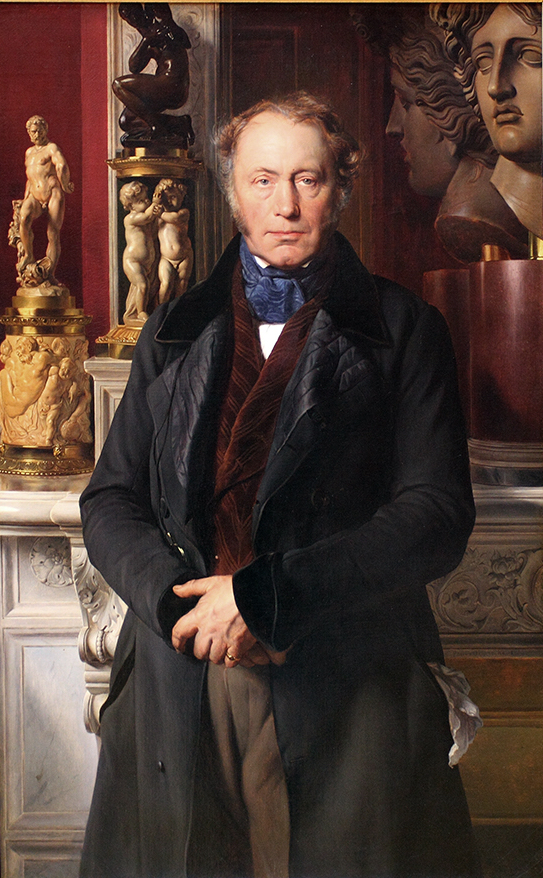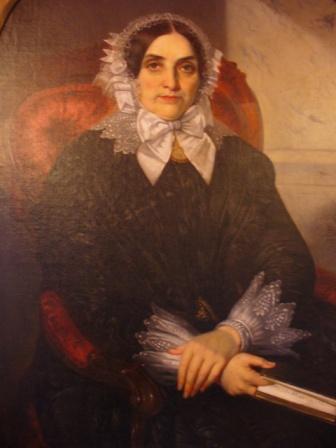|
James-Alexandre De Pourtalès
James-Alexandre de Pourtalès, Comte de Pourtalès-Gorgier (28 November 1776 – 24 March 1855) was a Swiss-French banker, diplomat and art collector. Early life The Count de Pourtalès was born in Neuchâtel, then in the Principality of Neuchâtel under Prussian rule, into a large family of Protestant financiers on 28 November 1776. He was the son of Countess Rose Augustine Marie de Luze (1751–1791) and Jacques-Louis de Pourtalès (1722–1814), a banker in Naples who amassed a fortune in commerce and was made a count by King Frederick William II. Among his siblings were Louis de Pourtalès (husband of Sophie d'Audanger) and Frédéric de Pourtalès (husband of Marie Louise de Castellane and grandfather of Friedrich von Pourtalès). His paternal grandparents were Jérémie de Pourtalès and Marguerite de Luze (who was the younger sister of his maternal great-grandfather). The Pourtalès family were French Huguenots who settled in Neuchâtel following the revocation of the ... [...More Info...] [...Related Items...] OR: [Wikipedia] [Google] [Baidu] |
Swiss People
The Swiss people (, , , ) are the citizens of the multi-ethnic Swiss Confederation (Switzerland) regardless of ethno-cultural background or people of self-identified Swiss ancestry. The number of Swiss nationals has grown from 1.7 million in 1815 to 8.7 million in 2020. More than 1.5 million Swiss citizens hold multiple citizenship. About 11% of citizens live abroad (0.8 million, of whom 0.6 million hold multiple citizenship). About 60% of those living abroad reside in the European Union (0.46 million). The largest groups of Swiss descendants and nationals outside Europe are found in the United States, Brazil, and Canada. Although the modern state of Switzerland originated in 1848, the period of romantic nationalism, Switzerland is not a nation-state and the Swiss are not a single ethnic group. Rather, Switzerland is a confederacy (') or ' ("nation of will", "nation by choice", that is, a consociational state), a term coined in conscious contrast to "nation" in the conv ... [...More Info...] [...Related Items...] OR: [Wikipedia] [Google] [Baidu] |
Colombier, Neuchâtel
Colombier () is a former Municipalities of Switzerland, municipality in the Boudry District in the canton of Neuchâtel in Switzerland. The municipalities of Auvernier, Bôle and Colombier merged on 1 January 2013 into the new municipality of Milvignes.Amtliches Gemeindeverzeichnis der Schweiz published by the Swiss Federal Statistical Office accessed 2 January 2013 History [...More Info...] [...Related Items...] OR: [Wikipedia] [Google] [Baidu] |
Frederick William III Of Prussia
Frederick William III (; 3 August 1770 – 7 June 1840) was King of Prussia from 16 November 1797 until his death in 1840. He was concurrently Elector of Brandenburg in the Holy Roman Empire until 6 August 1806, when the empire was dissolved. Frederick William III ruled Prussia during the times of the Napoleonic Wars. The king reluctantly joined the Sixth Coalition against Napoleon in the German campaign of 1813. Following Napoleon's defeat, he took part in the Congress of Vienna, which assembled to settle the political questions arising from the new, post-Napoleonic order in Europe. His primary interests were internal – the reform of Prussia's Protestant churches. He was determined to unify the Protestant churches to homogenize their liturgy, organization, and architecture. The long-term goal was to have fully centralized royal control of all the Protestant churches in the Prussian Union of Churches. The king was said to be extremely shy and indecisive. His wife Queen ... [...More Info...] [...Related Items...] OR: [Wikipedia] [Google] [Baidu] |
King Of Prussia
The monarchs of Prussia were members of the House of Hohenzollern who were the hereditary rulers of the former German state of Prussia from its founding in 1525 as the Duchy of Prussia. The Duchy had evolved out of the Teutonic Order, a Roman Catholic crusader state and theocracy located along the eastern coast of the Baltic Sea. The Teutonic Knights were under the leadership of a Grand Master, the last of whom, Albert, converted to Protestantism and secularized the lands, which then became the Duchy of Prussia. The Duchy was initially a vassal of the Kingdom of Poland, as a result of the terms of the Prussian Homage whereby Albert was granted the Duchy as part of the terms of peace following the Prussian War. When the main line of Prussian Hohenzollerns died out in 1618, the Duchy passed to a different branch of the family, who also reigned as Electors of Brandenburg in the Holy Roman Empire. While still nominally two different territories, Prussia under the suzerainty o ... [...More Info...] [...Related Items...] OR: [Wikipedia] [Google] [Baidu] |
Chamberlain (office)
A chamberlain (Medieval Latin: ''cambellanus'' or ''cambrerius'', with charge of treasury ''camerarius'') is a senior royal official in charge of managing a royal household. Historically, the chamberlain superintends the arrangement of domestic affairs and was often also charged with receiving and paying out money kept in the royal chamber. The position was usually awarded as an honour to a high-ranking member of the nobility (nobleman) or the clergy, often a favourite, royal favourite. Roman emperors appointed this officer under the title of ''cubicularius''. The Camerlengo of the Holy Roman Church, Chamberlain of the Holy Roman Church enjoys very extensive powers, having the revenues of the papal household under his charge. As a sign of their dignity, chamberlains bore a key, which in the seventeenth century was often silvered, and actually fitted the door-locks of chamber rooms. Since the eighteenth century, it has turned into a merely symbolic, albeit splendid, Order of prece ... [...More Info...] [...Related Items...] OR: [Wikipedia] [Google] [Baidu] |
Fief
A fief (; ) was a central element in medieval contracts based on feudal law. It consisted of a form of property holding or other rights granted by an overlord to a vassal, who held it in fealty or "in fee" in return for a form of feudal allegiance, services or payments. The fees were often lands, land revenue or revenue-producing real property like a watermill, held in feudal land tenure: these are typically known as fiefs or fiefdoms. However, not only land but anything of value could be held in fee, including governmental office, rights of exploitation such as hunting, fishing or felling trees, monopolies in trade, money rents and tax farms. There never existed a standard feudal system, nor did there exist only one type of fief. Over the ages, depending on the region, there was a broad variety of customs using the same basic legal principles in many variations. Terminology In ancient Rome, a " benefice" (from the Latin noun , meaning "benefit") was a gift of land () f ... [...More Info...] [...Related Items...] OR: [Wikipedia] [Google] [Baidu] |
Lord Of Gorgier
Gorgier is a former municipality in the district of Boudry in the canton of Neuchâtel in Switzerland. On 1 January 2018 the former municipalities of Bevaix, Saint-Aubin-Sauges, Gorgier, Vaumarcus, Montalchez and Fresens merged into the new municipality of La Grande-Béroche. History Gorgier is first mentioned in 1252 as ''de Corgie''. Geography Gorgier has an area, , of . Of this area, or 33.3% is used for agricultural purposes, while or 56.2% is forested. Of the rest of the land, or 8.3% is settled (buildings or roads) and or 2.2% is unproductive land.Swiss Federal Statistical Office-Land Use Statistics 2009 data accessed 25 March 2010 Of the built up area, housing and buildings made up 4.5% and transportation infrastructure made up 2.6%. Out ... [...More Info...] [...Related Items...] OR: [Wikipedia] [Google] [Baidu] |
Seigneury
A seigneur () or lord is an originally feudal system, feudal title in Ancien Régime, France before the French Revolution, Revolution, in New France and British North America until 1854, and in the Channel Islands to this day. The seigneur owned a seigneurie, seigneury, or lordship—a form of title or land tenure—as a fief, with its associated obligations and rights over person and property. In this sense, a seigneur could be an individualmale or female, high or low-bornor a collective entity, typically a religious community such as a monastery, seminary, college, or parish. In the wake of the French Revolution, seigneurialism was repealed in France on 4 August 1789 and in the Province of Canada on 18 December 1854. Since then, the feudal title has only been applicable in the Channel Islands and for sovereign princes by their families. Terms The English seigneur is borrowed from the French , which descends from Middle French , from Old French (oblique form of ''sire''), f ... [...More Info...] [...Related Items...] OR: [Wikipedia] [Google] [Baidu] |
University Of Chicago Press
The University of Chicago Press is the university press of the University of Chicago, a Private university, private research university in Chicago, Illinois. It is the largest and one of the oldest university presses in the United States. It publishes a wide range of academic titles, including ''The Chicago Manual of Style'', numerous academic journals, and advanced monographs in the academic fields. The press is located just south of the Midway Plaisance on the University of Chicago campus. One of its quasi-independent projects is the BiblioVault, a digital repository for scholarly books. History The University of Chicago Press was founded in 1890, making it one of the oldest continuously operating university presses in the United States. Its first published book was Robert F. Harper's ''Assyrian and Babylonian Letters Belonging to the Kouyunjik Collections of the British Museum''. The book sold five copies during its first two years, but by 1900, the University of Chicago Pr ... [...More Info...] [...Related Items...] OR: [Wikipedia] [Google] [Baidu] |
Canton Of Neuchâtel
The Republic and Canton of Neuchâtel (; ; ; ) is a mostly French-speaking canton in western Switzerland. In 2007, its population was 169,782, of whom 39,654 (or 23.4%) were foreigners. The capital is Neuchâtel. History County of Neuchâtel Neuchâtel has a unique history as the only part of present-day Switzerland to enter the Confederation as a principality (on 19 May 1815). Its first recorded ruler, Rudolph III of Burgundy, mentioned Neuchâtel in his will in 1032. The dynasty of Ulrich count of Fenis (Hasenburg) took over the town and its territories in 1034. The dynasty prospered and, by 1373, all the lands now part of the canton belonged to the count. In 1405, the cities of Bern and Neuchâtel entered a union. The lands of Neuchâtel had passed to the Zähringen lords of Freiburg in the late 14th century as inheritance from the childless Elisabeth, Countess of Neuchâtel, to her nephews, and then in 1458 to margraves of Sausenburg who belonged to the House of Bad ... [...More Info...] [...Related Items...] OR: [Wikipedia] [Google] [Baidu] |






